| Lets look at some labels! |
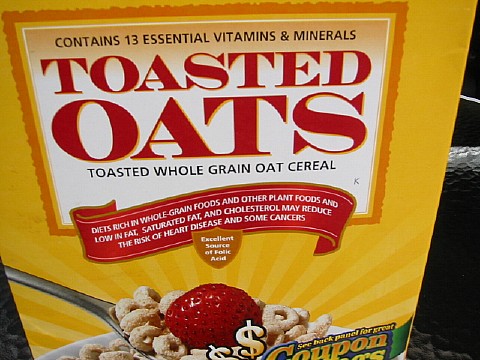 |
| C. COMPLEX CARBOHYDRATES: Polysaccharides |
|
Now we're ready for
2. Glycogen. Watch the Video Clip below to
begin this part.
|
| Video Clip: Glycogen approximately 5 minutes |
|
Here is a link to the above video: https://video.lanecc.edu/media/Polysaccharide+Glycogen/0_7exc225t/28810702 |
| The Video Clip says that the
body can make glycogen from eating foods rich in starch
and sugar. Starch and sugar are broken down into
monosaccharides, and ultimately become glucose which can
then be stored as glycogen. As mentioned before,
WHOLE foods are the best way to get this sugar and
starch because they also provide fiber, vitamins,
minerals and phytochemicals. An important point in your lecture outline is that although glycogen is in BOTH the muscles & the liver, the glycogen in only ONE of those places can get into the blood and travel. Therefore only one of those places can provide glucose to the brain. Which glycogen source provides glucose for the brain? Click here if you think muscle glycogen provides glucose for the brain. Click here
if you think liver glycogen provides glucose for the
brain. |
| C. COMPLEX CARBOHYDRATES: Polysaccharides |
|
And now we're ready for 3. Fiber. Types- Soluble & Insoluble Here is a link to the above video: https://www.youtube.com/watch?v=nw8YvlfBF5Y |
| Lets look at some labels! |
 |
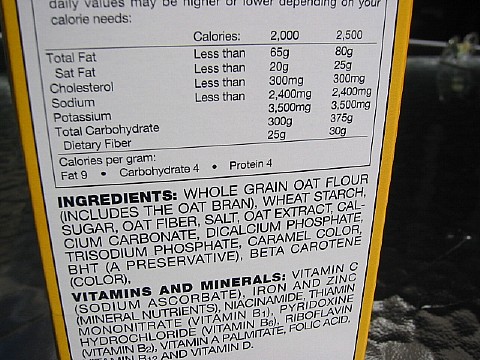 |
 Do you know what the 18g of other carbohydrate listed above is? Hopefully you were thinking starch. Remember the only carbohydrates in food are starch, sugar, and fiber. Usually only Total Carbohydrate, fiber and sugar are listed on the label. To calculate starch you would add up the sugar and fiber, and then subtract that number from the total carbohydrate. You can see from the label above that if you were to add 3g of fiber and 1g of sugar, you would get 4g. Subtract that from the total carbohydrate (22g), and you get 18g. Therefore, the cheerios would have 18g of starch per serving. |
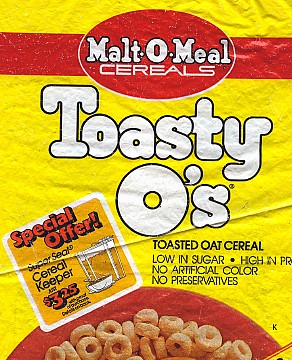
|
This is a 1984 label.
Below is a bigger
version of this label. |
 they DID NOT mention the fiber content. |
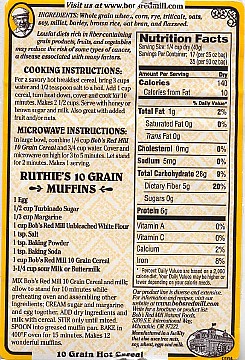 Above is a 10-grain hot cereal from Bob's Red Mill, a Portland company. Notice its high fiber content (5g). |
 One pear (above) has the same amount of dietary fiber as the serving of the 10-grain hot cereal (5g). |
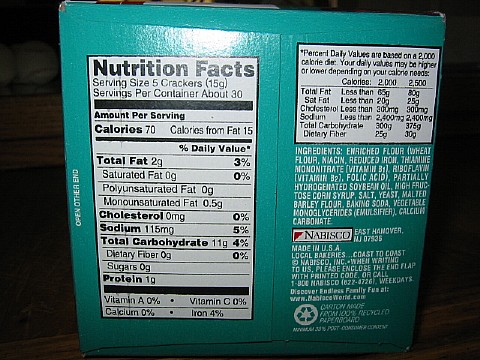 These saltines are made from wheat flour, but it's not WHOLE wheat. Notice the fiber content (0g). |
According to an article in Nutrition Action Health Letter, "most of
us overlook a growing source of the problem [gas]: inulin or chicory
root extract, one of the most popular ingredients in "high fiber"
foods". "Of all the fibers added to foods,
inulin is the one that
probably causes the most intestinal gas," says fiber expert Joanne
Slavin, professor of nutrition at the University of Minnesota. "Inulin
contains sugars that our digestive enzymes can't break down."
So the sugars end up as food for the bacteria in the gut. "Inulin is quickly and completely
fermented in the large intestine," explains Slavin. And when your
bacteria finish fermenting it, you get stuck with the gas they give
off.
"Our review of studies found that inulin is generally well tolerated at levels up to 15 grams a day," says Slavin. But at around 20 grams, flatulence or bloating is more likely. "So dose is a big issue, and there's also individual variability."
Each serving of Fiber One 90 Calorie Brownies, Fiber One Cottage Cheese, and Yoplait Light with Fiber has five grams of fiber, and much of it is inulin. Some Fiber One Chewy Bars have up to nine grams.
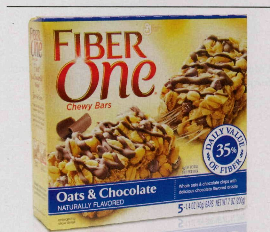
If you are interested in reading more about the gut and what types of foods can cause gut issues check out, "Gut Myths?".